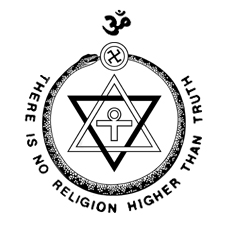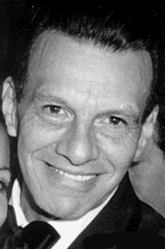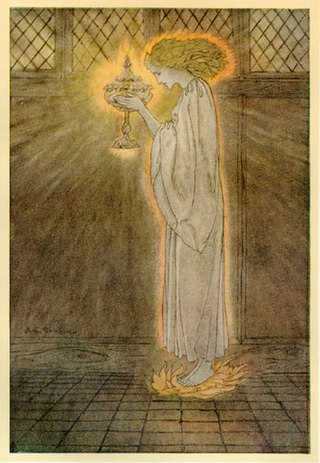
Alice Ann Bailey was a writer of more than twenty-four books on theosophical subjects, and was one of the first writers to use the term New Age. Bailey was born as Alice La Trobe-Bateman, in Manchester, England. She moved to the United States in 1907, where she spent most of her life as a writer and teacher.
Spiritual evolution, also called higher evolution, is the idea that the mind or spirit, in analogy to biological evolution, collectively evolves from a simple form dominated by nature, to a higher form dominated by the spiritual or divine. It is differentiated from the "lower" or biological evolution.

Ascended masters in a number of movements in the theosophical tradition are held to be spiritually enlightened beings who in past incarnations were ordinary humans, but who have undergone a series of spiritual transformations originally called initiations.
An adept is an individual identified as having attained a specific level of knowledge, skill, or aptitude in doctrines relevant to a particular author or organization.
In esoteric cosmology, a plane is conceived as a subtle state, level, or region of reality, each plane corresponding to some type, kind, or category of being.

Samael Aun Weor, born Víctor Manuel Gómez Rodríguez, was a spiritual teacher and author of over sixty books of esoteric spirituality. He taught and formed groups under the banner of "Universal Gnosticism", or simply gnosis. A prolific author of syncretistic books, Gómez first made a name in the early gnostic movement in his native country of Colombia, before moving to Mexico in 1956, where his movement gained increased popularity, and his works became popular among practitioners of occultism and esotericism, and were translated into other languages.

Root races are stages in human evolution in the esoteric cosmology of theosophist Helena Petrovna Blavatsky, as described in her book The Secret Doctrine (1888). These races existed mainly on now-lost continents. Blavatsky's model was developed by later theosophists, most notably William Scott-Elliot in The Story of Atlantis (1896) and The Lost Lemuria (1904). Annie Besant further developed the model in Man: Whence, How and Whither (1913). Both Besant and Scott-Elliot relied on information from Charles Webster Leadbeater obtained by "astral clairvoyance". Further elaboration was provided by Rudolf Steiner in Atlantis and Lemuria (1904). Rudolf Steiner, and subsequent theosophist authors, have called the time periods associated with these races Epochs.
The mental body is one of the subtle bodies in esoteric philosophies, in some religious teachings and in New Age thought. It is understood as a sort of body made up of thoughts, just as the emotional body consists of emotions and the physical body is made up of matter. In occult understanding, thoughts are not just subjective qualia, but have an existence apart from the associated physical organ, the brain.

In neo-Theosophy, the etheric body, ether-body, or æther body is the subtle body propounded in esoteric philosophies as the first or lowest layer in the human energy field or aura. The etheric body is said to be in immediate contact with the physical body and to sustain it and connect it with "higher" bodies. It is also said to consist of a finer substance, more pure and composed of smaller particles, than the ordinary matter of the physical plane.
Djwal Khul, is believed by some Theosophists and others to be a Tibetan disciple in "The Ageless Wisdom" esoteric tradition. The texts describe him as a member of the 'Spiritual Hierarchy', or 'Brotherhood', of Mahatmas, one of the Masters of the Ancient Wisdom, defined as the spiritual guides of mankind and teachers of ancient cosmological, metaphysical, and esoteric principles that form the origin of all the world's great philosophies, mythologies and spiritual traditions. According to Theosophical writings, Djwal Khul is said to work on furthering the spiritual evolution of our planet through the teachings offered in the 24 books by Alice Bailey of Esoteric Teachings published by The Lucis Trust ; he is said to have telepathically transmitted the teachings to Bailey and is thus regarded by her followers as the communications director of the Masters of the Ancient Wisdom.
The seven rays is a concept that has appeared in several religions and esoteric philosophies in both Western culture and in India since at least the sixth century BCE.
Master Jesus is the theosophical concept of Jesus in theosophy and the Ascended Master Teachings.
The Bridge to Freedom, an Ascended Master Teachings religion, was established in 1951 by Geraldine Innocente and other students of the Ascended Masters after she received what was believed to be an "anointing" to become a "messenger" for the Great White Brotherhood. This organization believed that their teachings had been given to humanity by the Ascended Masters. These were believed to be individuals who had lived in physical bodies, acquired the wisdom and mastery needed to become immortal and free of the cycles of "re-embodiment" and karma, attaining in this way their "Ascension". They considered the "ascension" to be the complete, permanent union of the purified outer self with the "I AM" Presence—meaning that true identity that is the unique individualization of God for each person.
The Great White Brotherhood, in belief systems akin to Theosophy and New Age, are said to be perfected beings of great power who spread spiritual teachings through selected humans. The members of the Brotherhood may be known as the Masters of the Ancient Wisdom, the Ascended Masters, the Church Invisible, or simply as the Hierarchy. The first person to talk about them in the West was Helena Petrovna Blavatsky (Theosophy), after she and other people claimed to have received messages from them. These included Helena Roerich, Alice A. Bailey, Guy Ballard, Geraldine Innocente, Elizabeth Clare Prophet, Bob Sanders, and Benjamin Creme.

Share International Foundation is a non-profit organization in London founded by Benjamin Creme (1922–2016) with sister organizations in Amsterdam, Tokyo, and Berkeley, California. From their 'about us' page, Share International describes the group as: "A worldwide network of individuals... whose purpose is to make known the fact that Maitreya ― the World Teacher for the coming age ― and his group, the Masters of Wisdom, are now among us..."

In Theosophy, Maitreya or Lord Maitreya is an advanced spiritual entity and high-ranking member of a reputed hidden spiritual hierarchy, the Masters of the Ancient Wisdom. According to Theosophical doctrine, one of the hierarchy's functions is to oversee the evolution of humankind; in concert with this function Maitreya is said to hold the "Office of the World Teacher". Theosophical texts posit that the purpose of this Office is to facilitate the transfer of knowledge about the true constitution and workings of Existence to humankind. Humanity is thereby assisted on its presumed cyclical, but ever progressive, evolutionary path. Reputedly, one way the knowledge transfer is accomplished is by Maitreya occasionally manifesting or incarnating in the physical realm; the manifested entity then assumes the role of World Teacher of Humankind.

Within the system of Theosophy, developed by occultist Helena Blavatsky and others since the second half of the 19th century, Theosophical mysticism draws upon various existing disciplines and mystical models, including Neo-platonism, Gnosticism, Western esotericism, Freemasonry, Hinduism and Buddhism.

Theosophy is a religion established in the United States during the late 19th century. It was founded primarily by the Russian Helena Blavatsky and draws its teachings predominantly from Blavatsky's writings. Categorized by scholars of religion as both a new religious movement and as part of the occultist stream of Western esotericism, it draws upon both older European philosophies such as Neoplatonism and Indian originated religions such as Hinduism and Buddhism.

Esoteric Buddhism is a book originally published in 1883 in London; it was compiled by a member of the Theosophical Society, A. P. Sinnett. It was one of the first books written for the purpose of explaining theosophy to the general public, and was "made up of the author's correspondence with an Indian mystic." This is the most significant theosophical work of the author. According to Goodrick-Clarke, it "disseminated the basic teachings of Theosophy in its new Asian cast."






